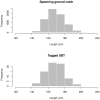Reproductive schedules in southern bluefin tuna: are current assumptions appropriate?
- PMID: 22514636
- PMCID: PMC3326032
- DOI: 10.1371/journal.pone.0034550
Reproductive schedules in southern bluefin tuna: are current assumptions appropriate?
Abstract
Southern bluefin tuna (SBT) appear to comprise a single stock that is assumed to be both mixed across its distribution and having reproductive adults that are obligate, annual spawners. The putative annual migration cycle of mature SBT consists of dispersed foraging at temperate latitudes with migration to a single spawning ground in the tropical eastern Indian Ocean. Spawning migrations have been assumed to target two peaks in spawning activity; one in September-October and a second in February-March. SBT of sizes comparable to that of individuals observed on the spawning ground were satellite tagged in the Tasman Sea region (2003-2008) and demonstrated both migrations to the spawning grounds and residency in the Tasman Sea region throughout the whole year. All individuals undertaking apparent spawning migrations timed their movements to coincide with the second recognised spawning peak or even later. These observations suggest that SBT may demonstrate substantial flexibility in the scheduling of reproductive events and may even not spawn annually as currently assumed. Further, the population on the spawning grounds may be temporally structured in association with foraging regions. These findings provide new perspectives on bluefin population and spatial dynamics and warrant further investigation and consideration of reproductive schedules in this species.
Conflict of interest statement
Figures


References
-
- Bayliff WH. A review of the biology and fisheries for northern bluefin tuna, (Thunnus thynnus), in the Pacific Ocean. FAO Fish Tech Paper. 1994;33612:244–295.
-
- Block BA, Dewar H, Blackwell SB, Williams TD, Prince ED, et al. Migratory movements, depth preferences and thermal biology of Atlantic bluefin tuna. Science. 2001;293:1310–1314. - PubMed
-
- Patterson TP, Evans K, Carter TI, Gunn JS. Movement and behaviour of large southern bluefin tuna (Thunnus maccoyii) in the Australian region determined using pop-up satellite archival tags. Fish Oceanog. 2008;17:352–367.
-
- Carey FG, Lawson KD. Temperature regulation in free-swimming bluefin tuna. Comp Biochem Physiol A Comp Physiol. 1973;44:375–392. - PubMed
-
- Dickson KA. Unique adaptations of the metabolic biochemistry of tunas and billfishes for life in the pelagic environment. Environ Biol Fishes. 1995;42:65–97.
Publication types
MeSH terms
LinkOut - more resources
Full Text Sources

